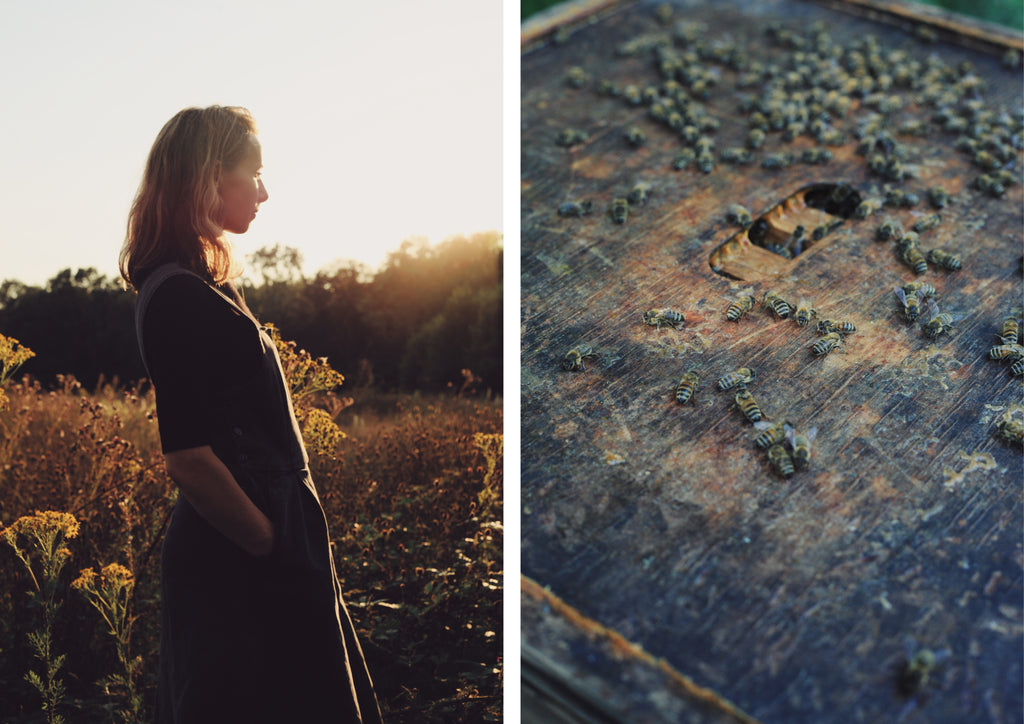
Just north of the chalky South Downs, beekeeper Lia Markwick’s home is in what she calls a sleepy old village. “Not much goes on,” she says, “but the local countryside is a great source of inspiration and beauty. I spend lots of time walking in the surrounding woodland.” It’s where she keeps some of her hives. “It provides a lot of forage for the bees, with wild cherry trees, hawthorn, and willow in spring. Then during the summer months, there is sweet chestnut, which is a great source of nectar.”
Lia’s fascination with bees runs in the family ‒ her father has been a beekeeper for 50 years. “He's got a really gentle nature when tending to the hives. He works very adeptly, but he's also extremely respectful in handling the bees at the same time. I always say, if I can build up half my dad's knowledge and skill in my lifetime, I would be very pleased with that. I'm forever learning from him.” Lia grew up in the village, called Ansty, and after some years away for university and work, she returned and began keeping bees with her father’s guidance. She started with just two hives; now, she has 20.


Lia has fond memories of being around bees when she was a child, particularly of the early starts. “I remember waking up very early, when it was still dark, to collect the bees before they stirred so we could take them down to the heather flowers in the New Forest,” she says. There were always beehives dotted around the garden. “It was a way of life, growing up, with the occasional swarm going overhead as we had dinner outside. So to me, looking after bees feels very natural.”
Today, she still uses some of her father’s old equipment, which he built or acquired from others in the beekeeping community. Some of the hives need repairing, but that’s something Lia enjoys. “It's lovely to reuse those hives. I like thinking about the history of them, imagining how many colonies the little wooden boxes have homed.” Preparing equipment, cleaning the hives and making frames, which hold the honeycomb, takes up most of her time. “I do a lot of frame-making. It's a huge part of beekeeping, making sure you've got the right equipment to be able to provide the bees with the space they need at the right time,” she says. Lia makes the frames in a honey shed, where she can close the doors to work without attracting the bees, as the scent of beeswax and honey will draw them close.

During the quieter winter months, Lia mainly works on cleaning the frames, melting down the excess wax and making candles. Lia explains that bees sometimes create comb, called burr comb, above and between the frames; she gathers this wax, along with slithers of wax cappings from the top of the harvested combs, melting it down and cleaning it. “We treasure all the beeswax that we get,” Lia says. “I've heard it referred to as a waste material, which baffles me, because I think it really should be treasured. The bees work so hard on it, and it takes such a long time to produce a tiny amount.”
In wintertime, she’ll warm up the gathered wax throughout the day, then hand-dip candles in the evening. “It's quite meditative. I like the uniqueness of each batch, because there are natural variations in shapes and sizes ‒ sometimes I lose count of how many dips I've done! I like that it preserves some of the season, taking something from the hive in the summer and then carrying it through to winter.”

For Lia, an hour of beekeeping can turn into another hour spent observing the wildflower field in the woodland behind her house. “I don't think it's been farmed within living memory which means it is so diverse. I know the field like the back of my hand, but it will always throw up another surprise, a new species of flower, and every year it changes.” She finds her connection with nature has become stronger through beekeeping. “I pay more attention to the natural world – not just to bees and insects, but to the flowers on which they forage. I can spend many an hour, sitting, watching bees forage the wildflower field looking at how each different flower will attract a different bee. Because it's not just about honeybees, there are many different species of bees and the field really attracts that diversity too.”
Following in her father’s footsteps, one of Lia’s main inspirations is helping the next generation to make early connections with nature. She’s given talks at local schools, an experience she describes as “absolutely petrifying,” where she showed the children a queen bee and they tasted some honey. Her son is apparently the biggest honey lover in the house. “He can discern between the flower types of different honeys,” Lia explains. “Sometimes we have borage honey, which is a really light honey. Then in the autumn, we have heather honey, which is really heady and aromatic.” Her daughter, who is a little older, enjoys candle-making. Lia’s affection for bees is infectious. “I feel very passionately about local honey. It's so much more than something sweet for the breakfast table. I love the idea that it captures a flavour of the field or the woodlands; it becomes a little pot of natural history.”
Interview by Alice Simkins.
Photographs by Stephen Winslade.
Follow Lia’s small business, The Sussex Bee, on Instagram.
Add a comment